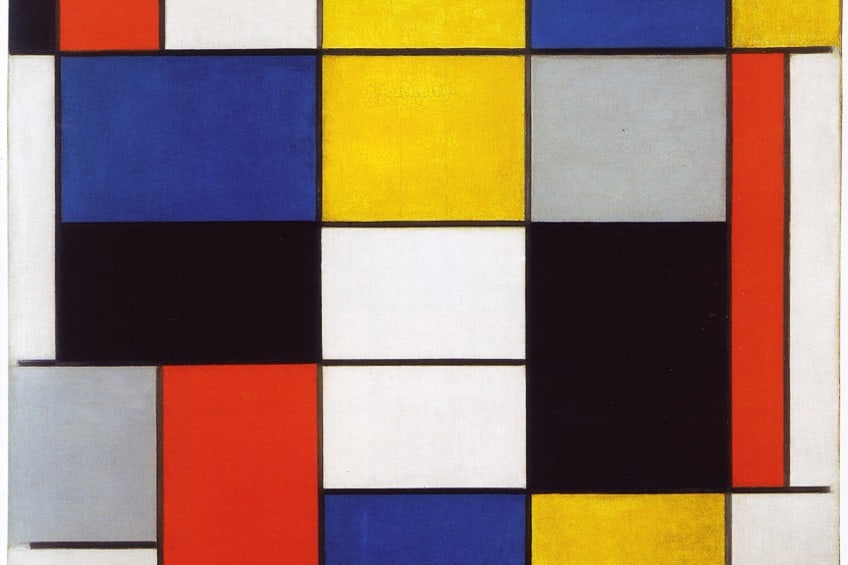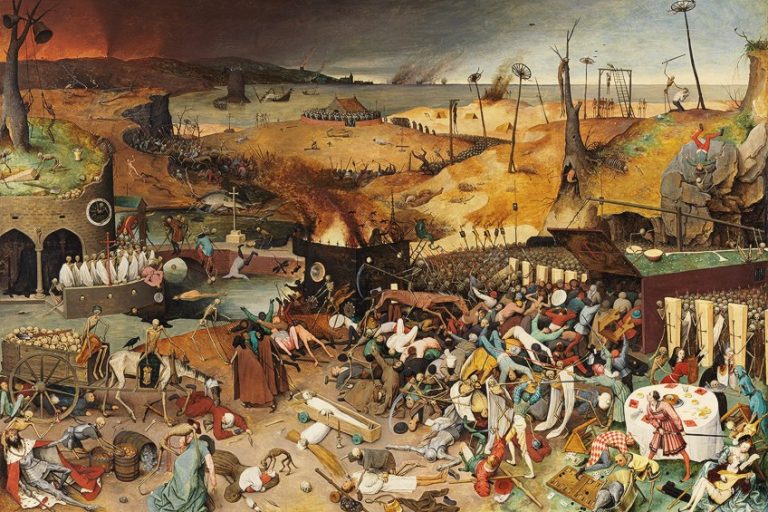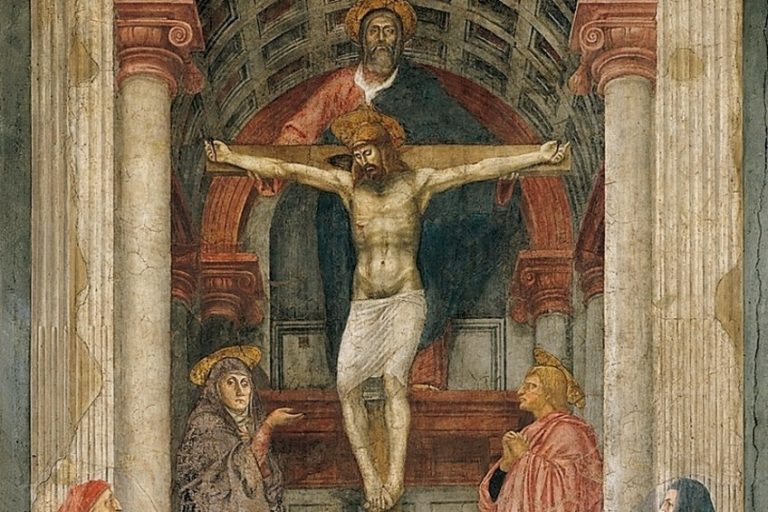Piet Mondrian Paintings – The Top 15 Works
Piet Mondrian, a pioneering figure in the realm of abstract art, left an indelible mark on the trajectory of modern painting with his iconic compositions characterized by geometric shapes and primary colors. Renowned for his distinctive style, Mondrian’s oeuvre reflects a profound exploration of harmony, balance, and the essence of pure form. Among his most celebrated works are pieces such as Composition with Red, Blue, and Yellow, Broadway Boogie Woogie, and Composition II in Red, Blue, and Yellow, each embodying his philosophical quest for a universal visual language. Through his relentless pursuit of simplicity and clarity, Mondrian not only revolutionized the visual arts but also laid the groundwork for the development of abstract expressionism and minimalist aesthetics in the 20th century.
Table of Contents
- 1 Who Was Piet Mondrian?
- 2 Top 15 Piet Mondrian Paintings to Know
- 2.1 The Red Tree (1908 – 1910)
- 2.2 Gray Tree (1911)
- 2.3 Pier and Ocean (Composition No. 10) (1915)
- 2.4 Composition with Gray and Light Brown (1918)
- 2.5 No. VI / Composition No.II (1920)
- 2.6 Tableau I (1921)
- 2.7 Composition with Large Red Plane, Yellow, Black, Gray and Blue (1921)
- 2.8 Composition A (1923)
- 2.9 Tableau I, Lozenge with Four Lines and Gray (1926)
- 2.10 Composition with Red, Blue and Yellow (1930)
- 2.11 Composition II in Red, Blue, and Yellow (1930)
- 2.12 Composition with Yellow, Blue and Red (1937 – 1942)
- 2.13 New York City (1942)
- 2.14 Broadway Boogie-Woogie (1942 – 1943)
- 2.15 Victory Boogie Woogie (1944)
- 3 Frequently Asked Questions
Who Was Piet Mondrian?
Piet Mondrian (1872 – 1944) was a Dutch painter and one of the most influential figures in the development of abstract art in the early 20th century. Born in Amersfoort, Netherlands, Mondrian initially trained as a traditional landscape painter before embracing the tenets of abstraction. He played a pivotal role in the De Stijl movement, which advocated for the reduction of form and color to their most essential elements.
Mondrian’s iconic style, characterized by geometric shapes, primary colors, and black grid lines, sought to distill the universal principles of harmony and balance.

Top 15 Piet Mondrian Paintings to Know
The Red Tree (1908 – 1910)
| Date | 1908 – 1910 |
| Medium | Oil on canvas |
| Dimensions (cm) | 70 x 99 |
| Where Is It Housed? | Gemeentemuseum Den Haag, The Hague, Netherlands |
The Red Tree (1910) by Piet Mondrian captures a transitional moment in the artist’s career as he navigates the shift from representational to abstract art. In this piece, Mondrian infuses the landscape with vibrant hues, particularly the striking red of the tree. While rooted in nature, the painting’s composition hints at Mondrian’s burgeoning interest in simplifying forms and intensifying colors for expressive effect.
The Red Tree serves as a precursor to Mondrian’s later abstract works, illustrating his experimentation with color and form as he moves towards a more distilled visual language.

Gray Tree (1911)
| Date | 1911 |
| Medium | Oil on canvas |
| Dimensions (cm) | 78.5 x 107.5 |
| Where Is It Housed? | Gemeentemuseum Den Haag, The Hague, Netherlands |
Gray Tree (1911) represents another significant step in Piet Mondrian’s artistic evolution towards abstraction. Departing from the vivid palette of The Red Tree, Mondrian adopts a subdued color scheme dominated by shades of gray.

The tree, rendered in angular, geometric forms, becomes a study in structure and rhythm rather than a faithful representation of nature. Gray Tree foreshadows Mondrian’s later grid compositions, as he begins to strip away unnecessary details in pursuit of geometric purity and visual harmony.
Pier and Ocean (Composition No. 10) (1915)
| Date | 1915 |
| Medium | Oil on canvas |
| Dimensions (cm) | 110 x 85 |
| Where Is It Housed? | Kröller-Müller Museum, Otterlo, Netherlands |
Pier and Ocean (Composition No. 10) (1915) exemplifies Piet Mondrian’s shift towards pure abstraction and his fascination with dynamic balance and movement. In this composition, Mondrian explores the interplay between horizontal and vertical lines, suggesting the rhythmic motion of waves and the architectural structure of a pier. The colors, though limited to primary hues, create a sense of vibrancy and energy within the composition.
Pier and Ocean marks a pivotal moment in Mondrian’s artistic journey, as he begins to distill his visual vocabulary to its most essential elements.

Composition with Gray and Light Brown (1918)
| Date | 1918 |
| Medium | Oil on canvas |
| Dimensions (cm) | 80.2 x 49.9 |
| Where Is It Housed? | Museum of Fine Arts, Houston, United States |
Composition with Gray and Light Brown (1918) reflects Piet Mondrian’s continued exploration of balance and harmony through geometric abstraction. Here, Mondrian employs a limited palette of muted tones, focusing on the interaction between shapes and lines to create a sense of equilibrium.
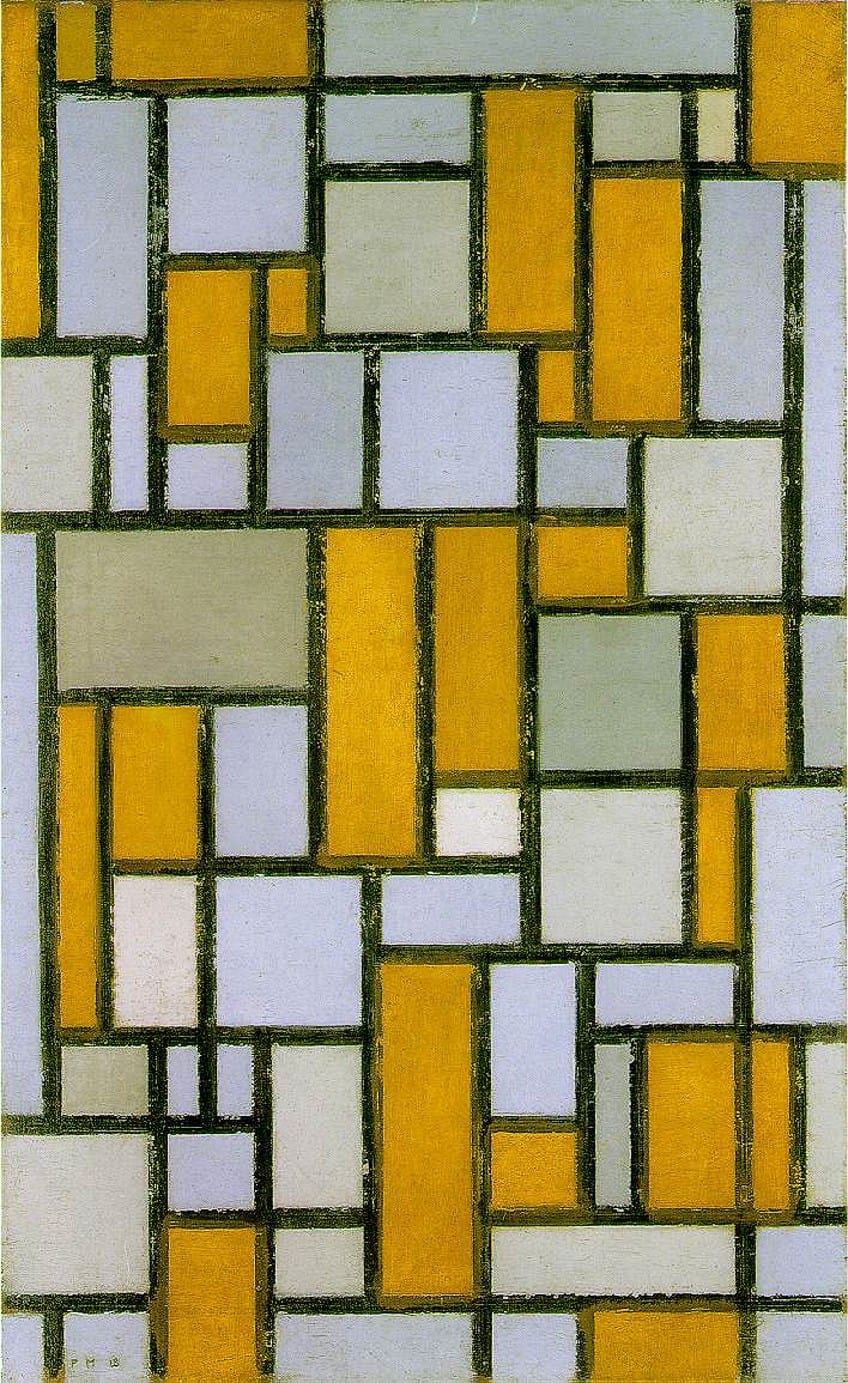
The composition exudes a quiet elegance, with each element carefully arranged to achieve a sense of visual balance and proportion. Composition with Gray and Light Brown exemplifies Mondrian’s commitment to simplification and refinement in his quest for universal harmony.
No. VI / Composition No.II (1920)
| Date | 1920 |
| Medium | Oil on canvas |
| Dimensions (cm) | 99.7 x 100.3 |
| Where Is It Housed? | Tate Museum, London, United Kingdom |
No. VI / Composition No.II (1920) encapsulates Piet Mondrian’s mature style, characterized by his iconic grid compositions and primary colors. In this work, Mondrian employs black lines to create a grid structure, within which blocks of primary colors are carefully arranged. Each element is precisely positioned to achieve a sense of balance and order, reflecting Mondrian’s belief in the universal principles of harmony and equilibrium.
No. VI / Composition No.II stands as a testament to Mondrian’s pioneering vision and his enduring contribution to the development of abstract art.

Tableau I (1921)
| Date | 1921 |
| Medium | Oil on canvas |
| Dimensions (cm) | 103 x 100 |
| Where Is It Housed? | Gemeentemuseum Den Haag, The Hague, Netherlands |
Tableau I (1921) by Piet Mondrian exemplifies his iconic grid compositions and exploration of primary colors. In this work, Mondrian creates a harmonious balance between horizontal and vertical lines, punctuated by blocks of red, yellow, black, gray, and blue.

Each element is meticulously arranged within the grid, emphasizing Mondrian’s commitment to clarity and order. Tableau I represents a pivotal moment in Mondrian’s career, as he refines his visual language to express universal truths through abstract form.
Composition with Large Red Plane, Yellow, Black, Gray and Blue (1921)
| Date | 1921 |
| Medium | Oil on canvas |
| Dimensions (cm) | 60.5 x 50 |
| Where Is It Housed? | Dallas Museum of Art, Texas, United States |
Composition with Large Red Plane, Yellow, Black, Gray and Blue (1921) showcases Piet Mondrian’s mastery of geometric abstraction and primary colors. The large red plane commands attention, offset by blocks of yellow, black, gray, and blue arranged within a precise grid structure. Mondrian’s use of color and form creates a dynamic interplay of shapes and lines, inviting viewers to contemplate the relationship between elements.
Composition with Large Red Plane epitomizes Mondrian’s quest for visual harmony and balance, reflecting his belief in the spiritual power of abstract art.
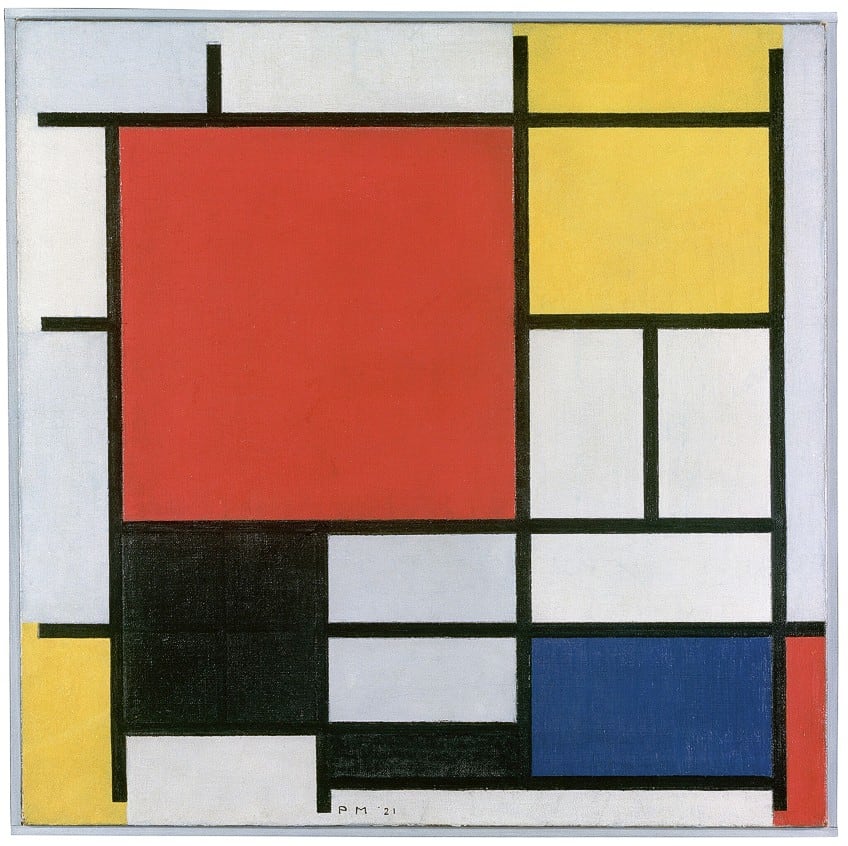
Composition A (1923)
| Date | 1923 |
| Medium | Oil on canvas |
| Dimensions (cm) | 90 x 91 |
| Where Is It Housed? | Galleria Nazionale d’Arte Moderna e Contemporanea, Rome, Italy |
Composition A (1923) by Piet Mondrian exemplifies his mature style and relentless pursuit of geometric purity. In this composition, Mondrian reduces forms to their most essential elements, employing primary colors and black lines to create a dynamic interplay of shapes.

The grid structure serves as a framework for Mondrian’s exploration of balance and rhythm, with each element carefully positioned to achieve a sense of equilibrium. Composition A embodies Mondrian’s belief in the universal language of abstraction, transcending the boundaries of representation to express fundamental truths of existence.
Tableau I, Lozenge with Four Lines and Gray (1926)
| Date | 1926 |
| Medium | Oil on canvas |
| Dimensions (cm) | 117.2 x 115.6 |
| Where Is It Housed? | Museum of Modern Art, New York City, United States |
Tableau I, Lozenge with Four Lines and Gray (1926) represents a continuation of Piet Mondrian’s exploration of geometric abstraction and spatial relationships. In this work, Mondrian introduces a lozenge shape, intersected by four black lines against a backdrop of gray. The composition is characterized by a sense of tension and balance, as Mondrian carefully manipulates the placement of lines and shapes within the pictorial space.
Tableau I, Lozenge with Four Lines and Gray reflects Mondrian’s ongoing experimentation with form and color, pushing the boundaries of abstraction to new heights.

Composition with Red, Blue and Yellow (1930)
| Date | 1930 |
| Medium | Oil on canvas |
| Dimensions (cm) | 45 x 45 |
| Where Is It Housed? | Kunsthaus Zürich, Zürich, Switzerland |
Composition with Red, Blue and Yellow (1930) stands as one of Piet Mondrian’s most iconic works, encapsulating his aesthetic principles and philosophical beliefs. In this composition, Mondrian reduces forms to their purest essence, employing primary colors and black lines arranged within a grid structure.
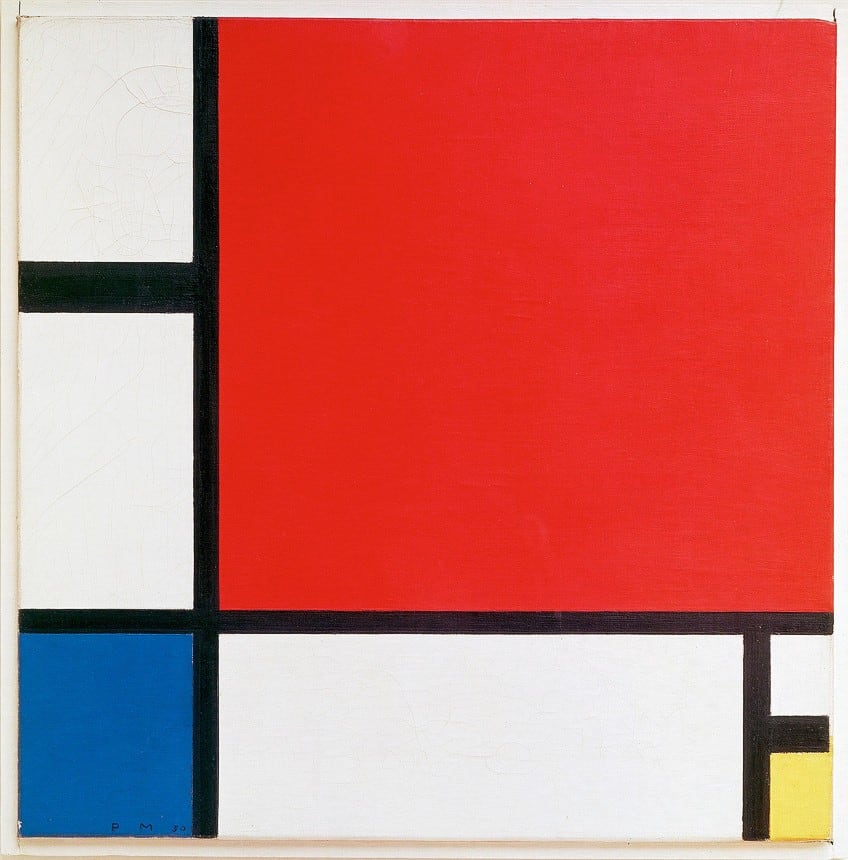
Each element is meticulously balanced to create a sense of visual equilibrium and harmony. Composition with Red, Blue and Yellow represents Mondrian’s quest for universal truths through abstract form, inviting viewers to contemplate the interconnectedness of the universe through the language of color and shape.
Composition II in Red, Blue, and Yellow (1930)
| Date | 1930 |
| Medium | Oil on canvas |
| Dimensions (cm) | 46 x 46 |
| Where Is It Housed? | Kunsthaus Zürich, Zürich, Switzerland |
Composition II in Red, Blue, and Yellow (1930) epitomizes Piet Mondrian’s mature style and his quest for visual harmony and balance. In this iconic work, Mondrian employs primary colors and black lines arranged within a grid structure to create a dynamic interplay of geometric forms.
Each element is meticulously balanced to achieve a sense of equilibrium, reflecting Mondrian’s belief in the universal language of abstraction and its capacity to convey fundamental truths.
Composition with Yellow, Blue and Red (1937 – 1942)
| Date | 1937 – 1942 |
| Medium | Oil on canvas |
| Dimensions (cm) | 72.7 x 69.2 |
| Where Is It Housed? | Tate Museum, London, United Kingdom |
Composition with Yellow, Blue and Red (1937 – 1942) showcases Piet Mondrian’s continued exploration of geometric abstraction and primary colors. In this composition, Mondrian simplifies forms to their most essential elements, utilizing bold blocks of yellow, blue, and red against a white background. The arrangement of colors and lines creates a sense of rhythm and balance within the composition, inviting viewers to contemplate the relationship between form and space.

New York City (1942)
| Date | 1942 |
| Medium | Oil on canvas |
| Dimensions (cm) | 119.3 x 114.2 |
| Where Is It Housed? | Musée National d’Art Moderne, Paris, France |
New York City (1942) captures Piet Mondrian’s fascination with the urban landscape and the energy of modern life. In this painting, Mondrian translates the bustling streets and dynamic architecture of New York City into a grid of intersecting lines and blocks of color.
The composition pulsates with vibrant energy, reflecting Mondrian’s belief in the transformative power of the city as a symbol of progress and innovation.

Broadway Boogie-Woogie (1942 – 1943)
| Date | 1942 – 1943 |
| Medium | Oil on canvas |
| Dimensions (cm) | 127 x 127 |
| Where Is It Housed? | Museum of Modern Art, New York City, United States |
Broadway Boogie-Woogie (1942 – 1943) stands as one of Piet Mondrian’s most celebrated works, embodying the rhythm and vitality of New York City’s bustling streets. In this composition, Mondrian employs a grid structure punctuated by blocks of primary colors, interspersed with smaller squares and rectangles reminiscent of city lights and traffic signals. The dynamic interplay of shapes and colors evokes the syncopated rhythm of jazz music, capturing the essence of the city’s vibrant cultural scene.

Victory Boogie Woogie (1944)
| Date | 1944 |
| Medium | Oil on canvas |
| Dimensions (cm) | 127 x 127 |
| Where Is It Housed? | Gemeentemuseum Den Haag, The Hague, Netherlands |
Victory Boogie Woogie (1944) represents Piet Mondrian’s final masterpiece and his ultimate exploration of rhythm and balance. In this unfinished work, Mondrian employs a grid of intersecting lines and brightly colored squares to create a sense of movement and dynamism. The composition exudes a sense of optimism and joy, reflecting Mondrian’s belief in art as a celebration of life and human achievement.
Despite its incomplete state, Victory Boogie Woogie remains a testament to Mondrian’s enduring legacy as a pioneer of abstract art.
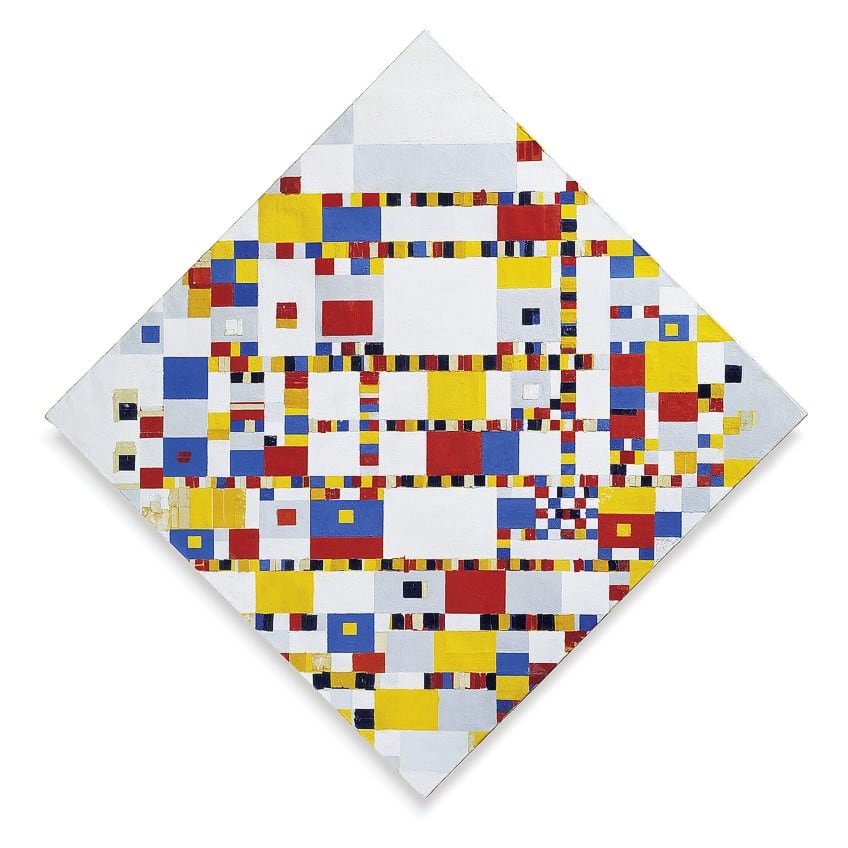
Piet Mondrian’s legacy endures as a beacon of innovation and creativity in the realm of modern art. His profound influence on abstract painting reverberates through generations, inspiring artists and audiences alike to explore the limitless possibilities of form, color, and composition. Mondrian’s commitment to simplicity and harmony resonates as strongly today as it did during his lifetime, serving as a testament to the enduring power of artistic vision. As we continue to reflect on his iconic works, we are reminded of Mondrian’s unwavering dedication to the pursuit of aesthetic perfection and his profound belief in the transformative potential of abstract expression. Through his art, Mondrian invites us to contemplate the beauty of simplicity and the boundless capacity of the human spirit to transcend the constraints of the material world.
Frequently Asked Questions
What Inspired Piet Mondrian’s Iconic Grid Compositions?
Piet Mondrian’s grid compositions were inspired by his quest for visual harmony and balance. Influenced by theosophy and the principles of Neo-Plasticism, Mondrian sought to distill reality to its purest form, believing that geometric abstraction could convey universal truths.
Why Did Mondrian Use Primary Colors So Prominently in His Paintings?
Mondrian believed that primary colors—red, blue, and yellow—were the most fundamental and pure hues, representing essential elements of the visual world. By using primary colors, Mondrian aimed to express the underlying harmony and balance inherent in the universe.
Why Did Mondrian Leave Some of His Paintings Unfinished?
Mondrian’s unfinished works, such as Victory Boogie Woogie, reflect his ongoing experimentation and exploration of rhythm and balance. Despite his meticulous planning, Mondrian often left his compositions open to interpretation, allowing for spontaneity and evolution in his artistic process.
Isabella studied at the University of Cape Town in South Africa and graduated with a Bachelor of Arts majoring in English Literature & Language and Psychology. Throughout her undergraduate years, she took Art History as an additional subject and absolutely loved it. Building on from her art history knowledge that began in high school, art has always been a particular area of fascination for her. From learning about artworks previously unknown to her, or sharpening her existing understanding of specific works, the ability to continue learning within this interesting sphere excites her greatly.
Her focal points of interest in art history encompass profiling specific artists and art movements, as it is these areas where she is able to really dig deep into the rich narrative of the art world. Additionally, she particularly enjoys exploring the different artistic styles of the 20th century, as well as the important impact that female artists have had on the development of art history.
Learn more about Isabella Meyer and the Art in Context Team.
Cite this Article
Isabella, Meyer, “Piet Mondrian Paintings – The Top 15 Works.” Art in Context. March 11, 2024. URL: https://artincontext.org/piet-mondrian-paintings/
Meyer, I. (2024, 11 March). Piet Mondrian Paintings – The Top 15 Works. Art in Context. https://artincontext.org/piet-mondrian-paintings/
Meyer, Isabella. “Piet Mondrian Paintings – The Top 15 Works.” Art in Context, March 11, 2024. https://artincontext.org/piet-mondrian-paintings/.


